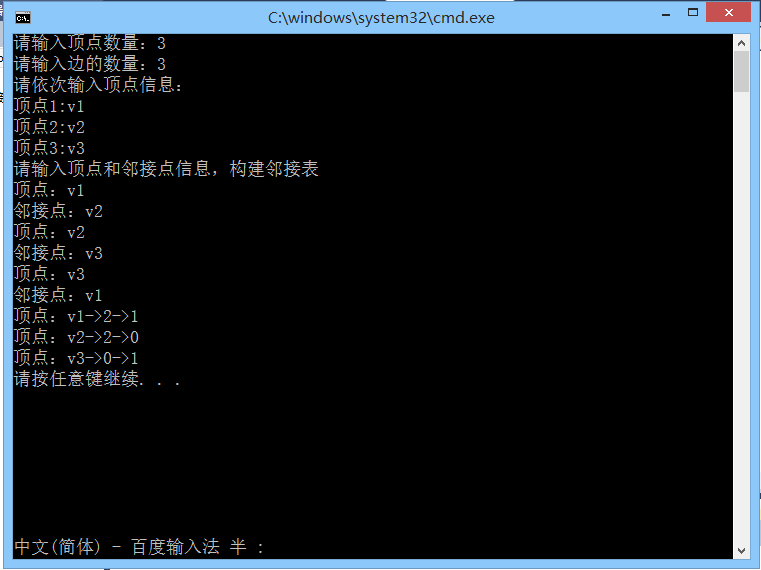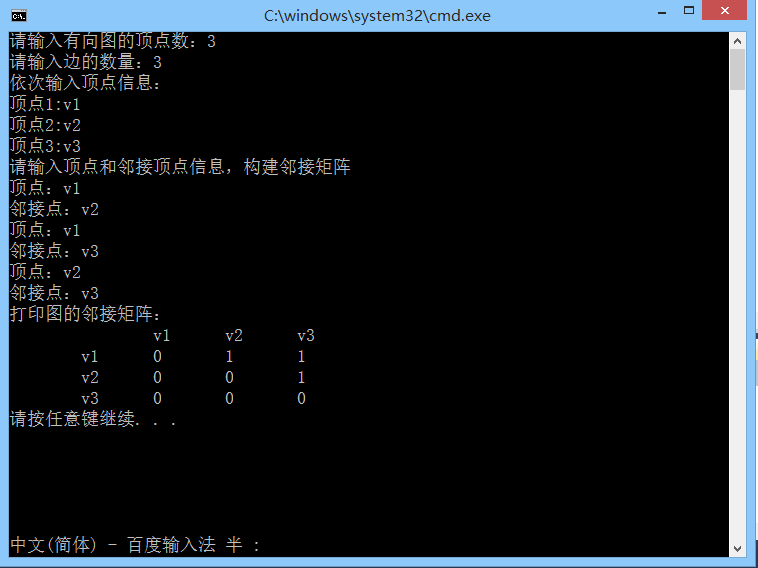1.无向图邻接矩阵
无向图的特点:
- 无向图的邻接矩阵是对称的
- 顶点i的度=第i行(列)中1的个数
GraphModel.h
#define OK 1#define ERROR 0#define MAX_VERTEX 100//图的类型枚举typedef enum{DG,//有向图UDG,//无向图DN,//有向网UDN//无向网//网是带权的图}GraphKind;//设置顶点的数据类型为字符串型,使用时记得分配内存typedef char * VerTexType;//设置权值类型为整数类型typedef int ArcType;//返回的状态类型typedef int status;
MatrixGraph.h
//数组(邻接矩阵)表示法
#include <stdio.h>
#include <stdlib.h>
#include "GraphModel.h"
#include <String.h>
//图的邻接矩阵存储表示
typedef struct{
VerTexType verTexs[MAX_VERTEX];//顶点数组
ArcType arcs[MAX_VERTEX][MAX_VERTEX]; //邻接矩阵
int verTexCount;//图的顶点数
int arcCount;//图的边/弧数
GraphKind kind;//图的类型
}MatrixGraph;
//使用邻接矩阵表示法创建无向图
status CreateUDG(MatrixGraph *G);
//返回某个顶点在顶点集合中的下标(从0开始),不存在返回-1
int LocateVex(MatrixGraph *G,VerTexType vex);
//
void TestMatrixGraph();
MatrixGraph.cpp
#include "MatrixGraph.h"
/*
无向图的特点:
1.无向图的邻接矩阵是对称的
2.顶点i的度=第i行(列)中1的个数
*/
//使用邻接矩阵表示法创建无向图
status CreateUDG(MatrixGraph *G){
G->kind=UDG;//设置当前创建图的类型为无向图
printf("请输入无向图的顶点数:");
scanf("%d",&G->verTexCount);
printf("请输入边的数量:");
scanf("%d",&G->arcCount);
printf("依次输入顶点信息:\n");
for(int i=0;i<G->verTexCount;i++){
G->verTexs[i]=(VerTexType)malloc(sizeof(char)*10);
printf("顶点%d:",i);
scanf("%s",G->verTexs[i]);
}
//初始化邻接矩阵,所有边的权值设置为0
for(int i=0;i<G->verTexCount;i++){
for(int j=0;j<G->verTexCount;j++){
G->arcs[i][j]=0;
}
}
printf("请输入顶点和邻接顶点信息,构建邻接矩阵\n");
for(int i=0;i<G->arcCount;i++){
VerTexType vex1=(VerTexType)malloc(sizeof(char)*10);
VerTexType vex2=(VerTexType)malloc(sizeof(char)*10);
printf("顶点:");
scanf("%s",vex1);
printf("邻接点:");
scanf("%s",vex2);
//分别获得两个顶点在顶点数组中的坐标
int x=LocateVex(G,vex1);
int y=LocateVex(G,vex2);
if(x==-1||y==-1){
return ERROR;
}
G->arcs[x][y]=1;
G->arcs[y][x]=G->arcs[x][y];//无向图的邻接矩阵是对称的
free(vex1);
free(vex2);
}
return OK;
}
//返回某个顶点在顶点集合中的下标(从0开始),不存在返回-1
int LocateVex(MatrixGraph *G,VerTexType vex){
int index=0;
while(index<G->verTexCount){
if(strcmp(G->verTexs[index],vex)==0){
break;
}
index++;
}
return index==G->verTexCount ? -1:index;
}
void TestMatrixGraph(){
MatrixGraph G;
//创建无向图
status status=CreateUDG(&G);
if(status ==ERROR){
printf("创建图失败,请检查后重试");
return;
}
printf("打印图的邻接矩阵:\n");
printf("\t");
for(int i=0;i<G.verTexCount;i++){
printf("\t%s",G.verTexs[i]);
}
printf("\n");
for(int i=0;i<G.verTexCount;i++){
printf("\t%s",G.verTexs[i]);
for(int j=0;j<G.verTexCount;j++){
printf("\t%d",G.arcs[i][j]);
}
printf("\n");
}
}
main.cpp
#include "MatrixGraph.h"
int main(){
TestMatrixGraph();
return 0;
}
2.有向图的邻接矩阵
特点:
- 有向图的邻接矩阵可能是不对称的
- 顶点的出度=第i行元素之和
- 顶点的入度=第i列元素之和
- 顶点的度=第i行元素之和+第i列元素之和
注:第i行含义:以结点Vi为尾的弧(即出度边)
第i列含义:以结点Vi为尾的弧(即入度边)
GraphModel.h
#define OK 1
#define ERROR 0
#define MAX_VERTEX 100
//图的类型枚举
typedef enum{
DG,//有向图
UDG,//无向图
DN,//有向网
UDN//无向网
//网是带权的图
}GraphKind;
//设置顶点的数据类型为字符串型,使用时记得分配内存
typedef char * VerTexType;
//设置权值类型为整数类型
typedef int ArcType;
//返回的状态类型
typedef int status;
MatrixGraph.h
//数组(邻接矩阵)表示法
#include <stdio.h>
#include <stdlib.h>
#include "GraphModel.h"
#include <String.h>
//图的邻接矩阵存储表示
typedef struct{
VerTexType verTexs[MAX_VERTEX];//顶点数组
ArcType arcs[MAX_VERTEX][MAX_VERTEX]; //邻接矩阵
int verTexCount;//图的顶点数
int arcCount;//图的边/弧数
GraphKind kind;//图的类型
}MatrixGraph;
//使用邻接矩阵表示法创建有向图
status CreateDG(MatrixGraph *G);
//返回某个顶点在顶点集合中的下标(从0开始),不存在返回-1
int LocateVex(MatrixGraph *G,VerTexType vex);
//
void TestMatrixGraph();
MatrixGraph.cpp
#include "MatrixGraph.h"
/*
无向图的特点:
1.无向图的邻接矩阵是对称的
2.顶点i的度=第i行(列)中1的个数
*/
//使用邻接矩阵表示法创建有向图
status CreateDG(MatrixGraph *G){
G->kind=DG;//设置当前创建图的类型为有向图
printf("请输入有向图的顶点数:");
scanf("%d",&G->verTexCount);
printf("请输入边的数量:");
scanf("%d",&G->arcCount);
printf("依次输入顶点信息:\n");
for(int i=0;i<G->verTexCount;i++){
G->verTexs[i]=(VerTexType)malloc(sizeof(char)*10);
printf("顶点%d:",i);
scanf("%s",G->verTexs[i]);
}
//初始化邻接矩阵,所有边的权值设置为0
for(int i=0;i<G->verTexCount;i++){
for(int j=0;j<G->verTexCount;j++){
G->arcs[i][j]=0;
}
}
printf("请输入顶点和邻接顶点信息,构建邻接矩阵\n");
for(int i=0;i<G->arcCount;i++){
VerTexType vex1=(VerTexType)malloc(sizeof(char)*10);
VerTexType vex2=(VerTexType)malloc(sizeof(char)*10);
printf("顶点:");
scanf("%s",vex1);
printf("邻接点:");
scanf("%s",vex2);
//分别获得两个顶点在顶点数组中的坐标
int x=LocateVex(G,vex1);
int y=LocateVex(G,vex2);
if(x==-1||y==-1){
return ERROR;
}
G->arcs[x][y]=1;
//G->arcs[y][x]=G->arcs[x][y];//有向图的邻接矩阵可能不是对称的
free(vex1);
free(vex2);
}
return OK;
}
//返回某个顶点在顶点集合中的下标(从0开始),不存在返回-1
int LocateVex(MatrixGraph *G,VerTexType vex){
int index=0;
while(index<G->verTexCount){
if(strcmp(G->verTexs[index],vex)==0){
break;
}
index++;
}
return index==G->verTexCount ? -1:index;
}
void TestMatrixGraph(){
MatrixGraph G;
//创建有向图
status status=CreateDG(&G);
if(status ==ERROR){
printf("创建图失败,请检查后重试");
return;
}
printf("打印图的邻接矩阵:\n");
printf("\t");
for(int i=0;i<G.verTexCount;i++){
printf("\t%s",G.verTexs[i]);
}
printf("\n");
for(int i=0;i<G.verTexCount;i++){
printf("\t%s",G.verTexs[i]);
for(int j=0;j<G.verTexCount;j++){
printf("\t%d",G.arcs[i][j]);
}
printf("\n");
}
}
main.cpp
#include "MatrixGraph.h"
int main(){
TestMatrixGraph();
return 0;
}
3.无向图的邻接表
GraphModel.h
#define OK 1
#define ERROR 0
#define MAX_VERTEX 100
//图的类型枚举
typedef enum{
DG,//有向图
UDG,//无向图
DN,//有向网
UDN//无向网
//网是带权的图
}GraphKind;
//设置顶点的数据类型为字符串型,使用时记得分配内存
typedef char * VerTexType;
//设置权值类型为整数类型
typedef int ArcType;
//返回的状态类型
typedef int status;
AdjListGraph.h
//图的邻接表表示法
#include "GraphModel.h"
#include <stdlib.h>
#include <stdio.h>
//边/弧的顶点、弧/边的结点结构
typedef struct node{
int adjVex;//该边指向这条边邻接点的下标
struct node *nextEdge;//指向下一条边结点的指针
struct node *nextArc;//指向下一个弧结点的指针
ArcType weight;//权重
}EdgeNode,ArcNode;
//顶点的结点结构
typedef struct vexNode{
VerTexType vex; //顶点的取值
EdgeNode *firstEdge; //指向第一条边的指针
ArcNode *firstArc; //指向第一条弧的指针
}VNode,AdjList[MAX_VERTEX]; //AdjList表示邻接表类型
//邻接表实现的图结构
typedef struct adjGraph{
AdjList vexes; //顶点数组
int VexCount; //顶点数量
int degeCount; //图的边数
int arcCount; //图的弧数
GraphKind kind; //图的类型
/*
union{
int degeCount; //图的边数
int arcCount; //图的弧数
}
*/
}AdjListGraph;
//采用邻接表表示法创建无向图
status CreateUDG_AdjList(AdjListGraph *G);
//返回顶点vex在顶点数组中的下标,没有找到就返回-1
int LocateVex_AdjList(AdjListGraph *G,VerTexType vex);
//测试函数
void TestAdjGraph();
AdjListGraph.cpp
#include "AdjListGraph.h"
#include <string.h>
//采用邻接表表示法创建无向图
status CreateUDG_AdjList(AdjListGraph *G){
G->kind=UDG;
printf("请输入顶点数量:");
scanf("%d",&G->VexCount);
printf("请输入边的数量:");
scanf("%d",&G->degeCount);
printf("请依次输入顶点信息:\n");
for(int i=0;i<G->VexCount;i++){
G->vexes[i].vex=(VerTexType)malloc(sizeof(char) *10);
printf("顶点%d:",i+1);
scanf("%s",G->vexes[i].vex);
//初始化邻接表,把边置空
G->vexes[i].firstEdge=NULL;
}
printf("请输入顶点和邻接点信息,构建邻接表\n");
for(int i=0;i<G->degeCount;i++){
VerTexType vex1=(VerTexType)malloc(sizeof(char) *10);
VerTexType vex2=(VerTexType)malloc(sizeof(char) *10);
printf("顶点:");
scanf("%s",vex1);
printf("邻接点:");
scanf("%s",vex2);
int x=LocateVex_AdjList(G,vex1);
int y=LocateVex_AdjList(G,vex2);
if(x==-1||y==-1){
free(vex1);
free(vex2);
return ERROR;
}
EdgeNode *edgeNode=(EdgeNode *)malloc(sizeof(EdgeNode));
edgeNode->adjVex=x;
edgeNode->nextEdge=G->vexes[y].firstEdge;
edgeNode->weight=0;
G->vexes[y].firstEdge=edgeNode;
edgeNode=(EdgeNode *)malloc(sizeof(EdgeNode));
edgeNode->adjVex=y;
edgeNode->nextEdge=G->vexes[x].firstEdge;
edgeNode->weight=0;
G->vexes[x].firstEdge=edgeNode;
free(vex1);
free(vex2);
}
return OK;
}
//测试函数
void TestAdjGraph(){
AdjListGraph G;
status status=CreateUDG_AdjList(&G);
for(int i=0;i<G.VexCount;i++){
VNode vNode=G.vexes[i];
printf("顶点:%s",vNode.vex);
EdgeNode * eNode=vNode.firstEdge;
while(eNode){
printf("->%d",eNode->adjVex);
eNode=eNode->nextEdge;
}
printf("\n");
}
}
//返回顶点vex在顶点数组中的下标,没有找到就返回-1
int LocateVex_AdjList(AdjListGraph *G,VerTexType vex){
int index=-1;
for(int i=0;i<G->VexCount;i++){
if(strcmp(vex,G->vexes[i].vex)==0){
index=i;
break;
}
}
return index;
}
main.cpp
#include "AdjListGraph.h"
int main(){
TestAdjGraph();
return 0;
}

2021.11.25



